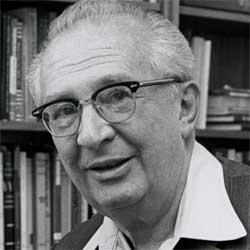Jacob Rabinow

Jacob Rabinow
Jacob Rabinow (1910-1999) was one of the most creative, dedicated, wide-ranging, productive, and colorful civil servants ever to grace the offices and laboratories of the United States Government. Despite the whirling technological changes that occurred during Rabinow's seven-decade career, the prolific scientist always seemed to be two steps ahead of everyone else.
He was born in Kharkov, Ukraine in 1910. During the Bolshevik Revolution in 1917, he and his parents fled to Siberia and then to China (1919). In 1921, after his father died, the family immigrated to the United States (New York). He grew up in Brooklyn, learning English at age eleven. He attended City College of New York, earning his Bachelor of Science (1933) and Master of Science (1934) degrees in electrical engineering there.
With a strong Russian accent and a fondness for humorous story-telling, Rabinow first joined the National Bureau of Standards (NBS, now NIST) in 1938 as a junior mechanical engineer. His inventive genius immediately found nurture in an environment that was very supportive. At times, however, the Bureau seemed a little strange and genteel to the Russian Jewish immigrant. By his own account, he was one of the first Jewish employees and maybe the first New Yorker at NBS.
Before he left government service in 1954 to form his own engineering company, Rabinow rose to the position of Chief of the Electromechanical Ordnance Division. He played critical roles in such important NBS World War II achievements as the development of the proximity fuse and the Bat guided missile. After working for a time at Control Data Corporation, which purchased his company in 1964, Rabinow returned to NBS in 1972 as Chief Research Engineer of the National Engineering Laboratory. Retiring in 1975, he returned once more as a rehired annuitant to serve as Chief Consultant for the Office of Energy-Related Inventions. In 1998, he became a guest researcher in the Office of Information Services.
Rabinow received his first patent in 1947 for a camera able to record the flight path of airplanes. By the end of his life, he held 230 U.S. patents and 70 foreign patents. Among these were mechanisms for the automatic regulation of clocks and watches, the former used in all American automobiles, the automatic letter-sorting machine still used by the U.S. Post Office, the magnetic particle clutch, formerly used in several European automobiles, now used in Subarus, airplanes, servo-mechanisms, and in a great many other machines, the world's first magnetic disc memory, the "best-match" principle in optical and magnetic character reading machines, many safety mechanisms for ordnance devices, and the straight-line phonograph. His patents could be classed under such diverse arts as photography, computer equipment, and card punching and sorting equipment.
For his scientific work, he held the following honors:
The Exceptional Service Award of the Department of Commerce (1949); the President's Certificate of Merit (1948); the War Department's Certificate of Appreciation (1949); the Naval Ordnance Development Award (1945); Certificate of Commendation from the NDRC (1945); the Edward Longstreth Medal from the Franklin Institute (1959); the CCNY Engineering School's 50th Anniversary Medal (1969); the Jefferson Medal Certificate from the American Patent Law Association (1973); the IEEE's Harry Diamond Award (1977); the Industrial Research and Development Scientist of the Year Award (1980); Doctor of Humane Letters, Towson State University (1983); the Lemelson-MIT Lifetime Achievement Award (1998).
He was a member of the National Academy of Engineering, the Cosmos Club, the Philosophical Society of Washington, and the Sigma XI. He was a Fellow of the IEEE, of the American Association for the Advancement of Science, and of the Audio Engineering Society.
In addition to his technical work, Jacob Rabinow delivered hundreds of talks on technologies and on inventions. He was a Regent's Lecturer at the University of California, Berkeley, a frequent guest on radio and television programs, and an author of many papers. His full-length book, "Inventing for Fun and Profit" was published in 1989 by San Francisco Press.
View photos of some of Rabinow’s many inventions in the NIST Digital Archives.
Contacts
-
NIST Research Library & Museum(301) 975-3052

